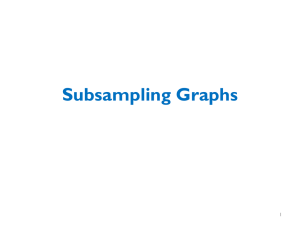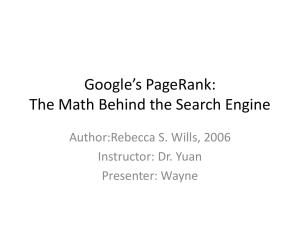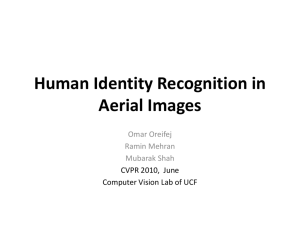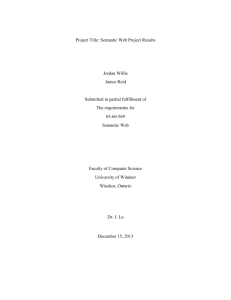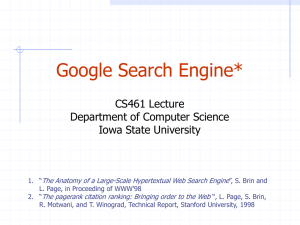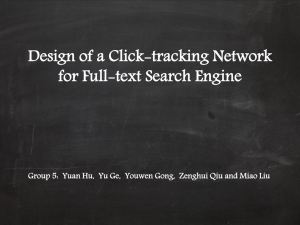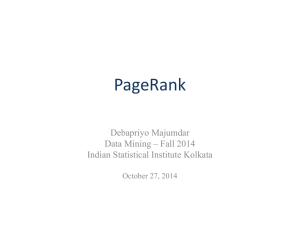CS315LinkAnalysis
advertisement
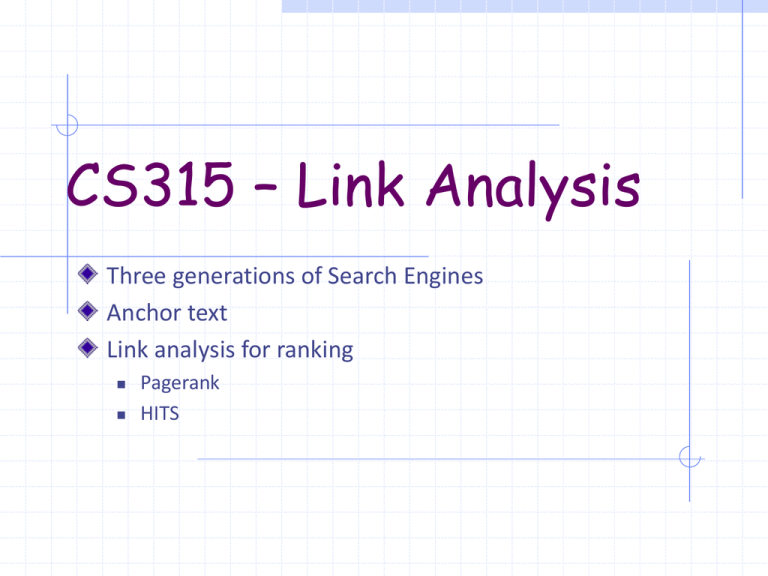
CS315 – Link Analysis Three generations of Search Engines Anchor text Link analysis for ranking Pagerank HITS 1st Generation: Content Similarity Content Similarity Ranking: The more rare words two documents share, the more similar they are Documents are treated as “bags of words” (no effort to “understand” the contents) Similarity is measured by vector angles t3 Query Results are ranked by sorting the angles between query and documents d 2 θ d1 t1 t2 But we also have links (los links!) Page B Page A Anchor text hyperlink Assumption 1: A hyperlink from a page denotes vote of confidence to second page (quality signal) Assumption 2: The anchor text of the hyperlink describes the target page (textual context) 2nd Generation: Add Popularity A hyperlink from a page in site A to some page in site B is considered a popularity vote from site A to site B Score of a page = number of in-links www.aa.com 1 www.bb.com 2 www.cc.com 1 Query Processing First retrieve all pages meeting the text query (say venture capital). Order these by the link popularity (of the page or the site) www.dd.com 2 www.zz.com 0 3rd Generation: Add Reputation Each page starts with some basic “reputation” (e.g., =1) and repeatedly distributes equal fractions to its links (while receiving from them) until some “equilibrium” The reputation “PageRank” of a page P = the sum of a fair fraction of the reputations PR(W ) PR(W1 ) PR(W 2 ) ...PR(W n ) O(W1) O(W 2 ) O(W n ) of all pages Pj that point to P Beautiful Math behind it PR = principal eigenvector of the web’s link matrix PR equivalent to the chance of randomly surfing to the page Idea similar to academic co-citations Roots of PR: Citation Analysis Citation frequency The kind of background work Deans are doing at tenure time Co-citation coupling frequency Co-citations with a given author measures “impact” Are you co-cited with influential publications? Bibliographic coupling frequency Articles that co-cite the same articles are related Citation indexing Who is author cited by? PageRank PR – Complete Definition W is a web page Wi are the web pages that have a link to W O(Wi) is the number of out-links from Wi t is the teleportation probability (e.g. 0.15) N is the size of the web (that we have seen) t PR(W1 ) PR(W 2 ) PR(W n ) PR(W ) (1 t)( ... ) N O(W1 ) O(W 2 ) O(W n ) W1 W1 W2 W2 W3 W3 W. PageRank: Iterative Computation t PR(W1 ) PR(W 2 ) PR(W n ) PR(W ) (1 t)( ... ) N O(W1 ) O(W 2 ) O(W n ) t is normally set to 0.15, but for this example, for simplicity let’s set it to 0.5 Set initial PR values to 1 Solve the following equations iteratively: PR(A) 0.5 /3 0.5PR(C) PR(B) 0.5 /3 0.5(PR(A) /2) PR(C) 0.5 /3 0.5(PR(A) /2 PR(B)) Example Computation of PR in Excel Pagerank – Matrix Multiplication Equivalent Def. Imagine a browser doing a random walk on web pages: Start at a random page P At each step, walk with equal probability out of the current page along one of the links on that page, 1/3 Continue doing this random 1/3 P walk for a long time 1/3 “In the steady state” each page has a long-term visit rate: Use this rate as the page’s score. Not quite enough The web is full of dead-ends. Random walk can get stuck in dead-ends. Makes no sense to talk about long-term visit rates. ?? Teleporting At a dead end, jump to a random web page. At any non-dead end, With probability, say, 15%, jump to a random web page. With remaining probability (85%), go out on a random link. t=0.15 is the “teleporting” parameter. Result of teleporting Now cannot get stuck locally. There exists a computable long-term rate at which any page is visited This not obvious, but it has been proven! How do we compute this visit rate? Markov chains: abstractions of random walks A Markov chain consists of n states, and an nn transition probability matrix P. At each step, we are in exactly one of the states. For 1 i,j n, the matrix entry Pij tells us the probability of j being the next state, given we are currently in state i. Clearly, for all i, n Pij 1. j 1 i Pij j Computing PR with Markov chains Example (next two slides): Represent the teleporting random walk with teleporting parameter t=15% as a Markov chain, for this graph: A B C D Computing P with Matrix Multiplication Start with Adjacency matrix A of the Web Graph If there is hyperlink from i to j, Aij = 1, else Aij = 0 If a row has all 0’s, replace each element by 1/N Else divide each 1 by the number of 1’s in the row Multiply the matrix by 1-t Add t/N to every entry of the resulting matrix A B C D P= Computing all Pageranks P= Theorem: Regardless of where we start, we eventually reach the steady state a. Start with any distribution (say x=(1 0 … 0)). After one step, we’re at xP; after two steps at xP2 , then xP3 and so on. “Eventually” means for “large” k, xPk = a. Algorithm: multiply x by increasing powers of P until the product looks stable. A B C D Pagerank summary Preprocessing: Given graph of links, build matrix P. From it compute a. The entry ai is a number between 0 and 1: the pagerank of page i. Query processing: Retrieve pages meeting query. Rank them by their pagerank. Order is query-independent If PR(A) > PR(B) for some query, it beats it in every query How is Pagerank used? http://www.google.com/corporate/tech.html PageRank Technology: PageRank reflects our view of the importance of web pages by considering more than 500 million variables and 2 billion terms. Pages that we believe are important pages receive a higher PageRank and are more likely to appear at the top of the search results. This claim has recently changed: “Today we use more than 200 signals, including PageRank, to order websites, and we update these algorithms on a weekly basis” Pagerank is dead, long live Pagerank!


